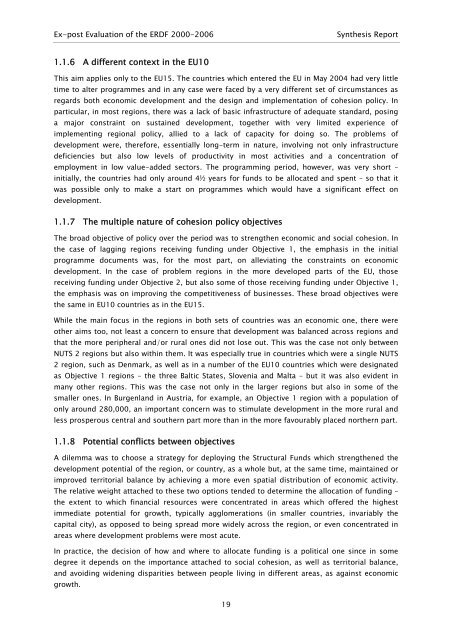Synthesis Report - European Commission - Europa
Synthesis Report - European Commission - Europa
Synthesis Report - European Commission - Europa
You also want an ePaper? Increase the reach of your titles
YUMPU automatically turns print PDFs into web optimized ePapers that Google loves.
Ex-post Evaluation of the ERDF 2000-2006<br />
<strong>Synthesis</strong> <strong>Report</strong><br />
1.1.6 A different context in the EU10<br />
This aim applies only to the EU15. The countries which entered the EU in May 2004 had very little<br />
time to alter programmes and in any case were faced by a very different set of circumstances as<br />
regards both economic development and the design and implementation of cohesion policy. In<br />
particular, in most regions, there was a lack of basic infrastructure of adequate standard, posing<br />
a major constraint on sustained development, together with very limited experience of<br />
implementing regional policy, allied to a lack of capacity for doing so. The problems of<br />
development were, therefore, essentially long-term in nature, involving not only infrastructure<br />
deficiencies but also low levels of productivity in most activities and a concentration of<br />
employment in low value-added sectors. The programming period, however, was very short –<br />
initially, the countries had only around 4½ years for funds to be allocated and spent – so that it<br />
was possible only to make a start on programmes which would have a significant effect on<br />
development.<br />
1.1.7 The multiple nature of cohesion policy objectives<br />
The broad objective of policy over the period was to strengthen economic and social cohesion. In<br />
the case of lagging regions receiving funding under Objective 1, the emphasis in the initial<br />
programme documents was, for the most part, on alleviating the constraints on economic<br />
development. In the case of problem regions in the more developed parts of the EU, those<br />
receiving funding under Objective 2, but also some of those receiving funding under Objective 1,<br />
the emphasis was on improving the competitiveness of businesses. These broad objectives were<br />
the same in EU10 countries as in the EU15.<br />
While the main focus in the regions in both sets of countries was an economic one, there were<br />
other aims too, not least a concern to ensure that development was balanced across regions and<br />
that the more peripheral and/or rural ones did not lose out. This was the case not only between<br />
NUTS 2 regions but also within them. It was especially true in countries which were a single NUTS<br />
2 region, such as Denmark, as well as in a number of the EU10 countries which were designated<br />
as Objective 1 regions – the three Baltic States, Slovenia and Malta – but it was also evident in<br />
many other regions. This was the case not only in the larger regions but also in some of the<br />
smaller ones. In Burgenland in Austria, for example, an Objective 1 region with a population of<br />
only around 280,000, an important concern was to stimulate development in the more rural and<br />
less prosperous central and southern part more than in the more favourably placed northern part.<br />
1.1.8 Potential conflicts between objectives<br />
A dilemma was to choose a strategy for deploying the Structural Funds which strengthened the<br />
development potential of the region, or country, as a whole but, at the same time, maintained or<br />
improved territorial balance by achieving a more even spatial distribution of economic activity.<br />
The relative weight attached to these two options tended to determine the allocation of funding –<br />
the extent to which financial resources were concentrated in areas which offered the highest<br />
immediate potential for growth, typically agglomerations (in smaller countries, invariably the<br />
capital city), as opposed to being spread more widely across the region, or even concentrated in<br />
areas where development problems were most acute.<br />
In practice, the decision of how and where to allocate funding is a political one since in some<br />
degree it depends on the importance attached to social cohesion, as well as territorial balance,<br />
and avoiding widening disparities between people living in different areas, as against economic<br />
growth.<br />
19

















